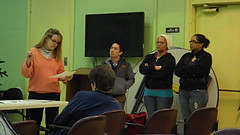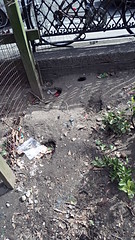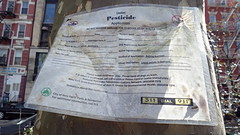Kathleen Webster has had enough of her unwelcome neighbors at Sara D. Roosevelt Park. She thinks the rat population has exploded since Hurricane Sandy, particularly around the Golden Age Center for senior citizens.
“I saw about forty of them crawling out of the garbage in back of the building,” she told Community Board 3’s parks committee last week. Ms. Webster, a representative of the SDR Park Coalition, said the health department “hasn’t been as diligent as it needs to be” about the increased rat population and asked the board to press for action.
Phil Abramson, a spokesperson for the parks department, confirmed that there had been an uptick in rats in recent weeks. As a result, the parks department has upped the amount of bait it uses. In addition to collecting trash daily, employees routinely patrol Roosevelt Park looking for rat burrows, then bait and destroy them, Mr. Abramson said. Several dozen of the holes were visible in the park yesterday morning.
Ms. Webster said she would like to see better containers for trash, such as the solar-powered trash compactors that appeared in Tompkins Square Park after an infestation there two summers ago. Even more frequent pickups, she said, would help alleviate the problem of spilled garbage.
Earlier this month, The Times reported that Hurricane Sandy dislodged the waterfront rat population and forced the rodents inland, where they resettled among the waterlogged debris and trash that sat for days. “They became so bad I couldn’t even take all the jobs,” a Lower East Side exterminator told The Times. Some members of the City Council are now calling for a six-month eradication program in addition to the city’s regular extermination regimen.
Some at Roosevelt Park haven’t noticed the explosion. One longtime East Village resident saw rats as an unavoidable annoyance. “A lot of things have changed in this neighborhood, but the rats haven’t,” said Mr. Clement, who declined to give his full name. “I can’t say whether there are more or less, but there have always been a lot.” He said he used to see traps around the park, “but not anymore.”







